ISSN
2307–3489 (Print), ІSSN
2307–6666
(Online)
Наука
та прогрес транспорту. Вісник
Дніпропетровського
національного університету залізничного
транспорту, 2018, №
2 (74)
МОДЕЛЮВАННЯ
ЗАДАЧ ТРАНСПОРТУ ТА ЕКОНОМІКИ
МОДЕЛЮВАННЯ
ЗАДАЧ ТРАНСПОРТУ
ТА
ЕКОНОМІКИ
UDC
[004.7-047.72]:656.2
I. V.
ZHUKOVYTS’KYY,
V. M.
Pakhomovа2*
1*Dep.
«Electronic Computing Machines», Dnipropetrovsk National University
of Railway Transport named after Academician V. Lazaryan, Lazaryan
St., 2,
Dnipro, Ukraine, 49010, tel. +38 (056) 373 15 89, e-mail
ivzhuk@ua.fm,
ORCID
0000-0002-3491-5976
2*Dep.
«Electronic Computing Machines», Dnipropetrovsk National University
of Railway Transport named after Academician V. Lazaryan, Lazaryan
St., 2,
Dnipro, Ukraine, 49010, tel. +38 (056) 373 15 89, e-mail
viknikpakh@gmail.com,
ORCID
0000-0002-0022-099X
IDENTIFYING THREATS IN
COMPUTER NETWORK BASED
ON MULTILAYER NEURAL
NETWORK
Purpose. Currently, there appear more often the reports of
penetration into computer networks and attacks on the Web-server.
Attacks are divided into the following categories: DoS, U2R, R2L,
Probe. The purpose of the article is to identify threats in a
computer network based on network traffic parameters using neural
network technology, which will protect the server. Methodology.
The detection of such threats as Back, Buffer_overflow,
Quess_password, Ipsweep, Neptune in the computer network is
implemented on the basis of analysis and processing of data on the
parameters of network connections that use the TCP/IP protocol stack
using the 19-1-25-5 neural network configuration in the Fann Explorer
program. When simulating the operation of the neural network, a
training (430 examples), a testing (200 examples) and a control
sample (25 examples) were used, based on an open KDDCUP-99 database
of 500000 connection records. Findings. The neural network
created on the control sample determined an error of 0.322. It is
determined that the configuration network 19-1-25-5 copes well with
such attacks as Back, Buffer_overflow and Ipsweep. To detect the
attacks of Quess_password and Neptune, the task of 19 network traffic
parameters is not enough. Originality. We obtained
dependencies of the neural network training time (number of epochs)
on the number of neurons in the hidden layer (from 10 to 55) and the
number of hidden layers (from 1 to 4). When the number of neurons in
the hidden layer increases, the neural network by Batch algorithm is
trained almost three times faster than the neural network by
Resilient algorithm. When the number of hidden layers increases, the
neural network by Resilient algorithm is trained almost twice as fast
as that by Incremental algorithm. Practical value. Based on
the network traffic parameters, the use of 19-1-25-5 configuration
neural network will allow to detect in real time the computer network
threats Back, Buffer_overflow, Quess_password, Ipsweep, Neptune and
to perform appropriate monitoring.
Keywords:
network traffic; threat; neural
network; sampling; hidden layer; hidden neurons; training algorithm;
number of epoch; error
Introduction
There have
recently been increasingly frequent computer penetration reports and
attacks on Web-server. Very often, intruders bypass established
protective devices. Attacks are carried out in a very short time and
the variety of threats is constantly increasing, which prevents from
detecting and preventing them with standard protective equipment
[2–3]. Existing approaches are characterized by a number of
features that hinder their use: low speed of work; poor accuracy [1,
13, 15]. To eliminate these shortcomings, a neural network
technology is proposed [1–4, 6–12]: multilayer perceptron;
Kohonen network; neuronetty network (hybrid system).
Attacks are
divided into the following categories [2, 14–15]: DoS
(Back, Land,
Neptune, Pod,
Smurf,
Teardrop), U2R
(Buffer_overflow, Loadmodule,
Perl, Rootkit),
R2L (Ftp_write,
Quess_passwd,
Imap, Multihop,
Phf, Spy,
Warezclient,
Warezmaster),
Probe (Ipsweep,
Hmap, Portsweep,
Satan). DoS
attack is
characterized by
the generation
of a
large amount
of traffic,
which leads
to overload
and lockup
of the
server; U2R
attack (User
to Root)
involves
receiving by
a registered
user of
administrator’s
privileges; R2L
attacks (Remote to Local) are characterized by access of an
unregistered user to a computer from
a
remote machine; Probe attacks include scanning of ports in order to
obtain confidential information.
At the present stage, various
solutions are offered for the modernization of existing computer
networks, in particular, in the information and telecommunication
system of the Prydniprovska railway [5, 16].
Purpose
To develop a method for
detecting threats in a computer network based on network traffic
parameters using a multi-layer neural network in the Fann Explorer
program.
Methodology
To
detect threats
we used
19 network
traffic
parameters ( )
[14]: package
type (TCP,
UDP, ICMP
and others);
service type
(http, telnet,
ftp_data,
eco_i,
private); flag;
number of
bytes from
source to
recipient;
number of
bytes from
recipient to
source; number
of hot
indicators;
successful
entrance; number
of compromised
conditions;
number of
connections to
the host
for 2 s;
number of
connections to
one service
for 2 s;
percentage of
connections to
the service
for 2 s;
percentage of
connection to
different hosts;
number of
connections to
the local
host installed
by the
remote side
for 2 s;
number of
connections to
the local
host installed
by the
remote side,
uses 1 service;
percentage of
connections to
this service;
percentage of
connections to
other services;
percentage of
connections to
the host
with the
port number
of the
source;
percentage of
connections with
a rej-type
error for
the recipient
host; percentage
of connections
with a
rej-type error
for the
service. On
the basis of
the values of
the set of
the attack
features, it is
necessary to
carry out the
classification conclusion
(
)
[14]: package
type (TCP,
UDP, ICMP
and others);
service type
(http, telnet,
ftp_data,
eco_i,
private); flag;
number of
bytes from
source to
recipient;
number of
bytes from
recipient to
source; number
of hot
indicators;
successful
entrance; number
of compromised
conditions;
number of
connections to
the host
for 2 s;
number of
connections to
one service
for 2 s;
percentage of
connections to
the service
for 2 s;
percentage of
connection to
different hosts;
number of
connections to
the local
host installed
by the
remote side
for 2 s;
number of
connections to
the local
host installed
by the
remote side,
uses 1 service;
percentage of
connections to
this service;
percentage of
connections to
other services;
percentage of
connections to
the host
with the
port number
of the
source;
percentage of
connections with
a rej-type
error for
the recipient
host; percentage
of connections
with a
rej-type error
for the
service. On
the basis of
the values of
the set of
the attack
features, it is
necessary to
carry out the
classification conclusion
( ,
,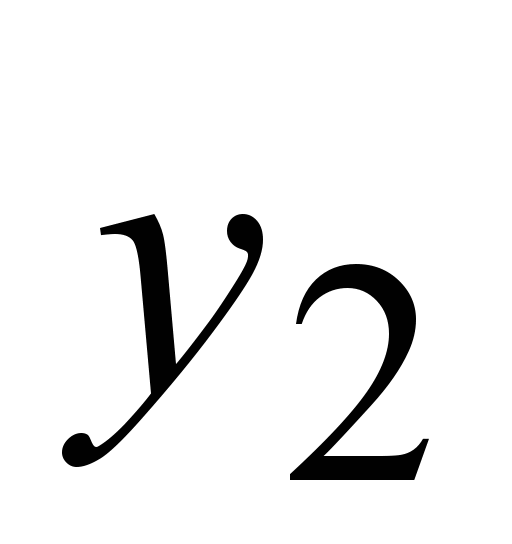 ,
, ,
, ,
, )
of the following threats: Back, Buffer_overflow, Quess_password,
Ipsweep, Neptune. Detection of threats in a computer network is
based on the analysis and processing of data on the parameters of
network connections using the TCP/IP protocol stack. As initial data
we used KDDCUP-99 database of 5,000,000 connection records (the
sequence of TCP packets for the final period, the start and end
points of which are clearly defined, during which the data is
transmitted from the sender's IP address to the recipient’s IP
address using the defined protocol). As a mathematical tool of
problem solution we took the neural network (NN) of the
configuration 19-1-25-5, where 19 is the number of neurons in the
input layer, 1 is the number of hidden layers, 25 is the number of
neurons in the hidden layer, and 5 is the number of neurons in the
resulting layer.
)
of the following threats: Back, Buffer_overflow, Quess_password,
Ipsweep, Neptune. Detection of threats in a computer network is
based on the analysis and processing of data on the parameters of
network connections using the TCP/IP protocol stack. As initial data
we used KDDCUP-99 database of 5,000,000 connection records (the
sequence of TCP packets for the final period, the start and end
points of which are clearly defined, during which the data is
transmitted from the sender's IP address to the recipient’s IP
address using the defined protocol). As a mathematical tool of
problem solution we took the neural network (NN) of the
configuration 19-1-25-5, where 19 is the number of neurons in the
input layer, 1 is the number of hidden layers, 25 is the number of
neurons in the hidden layer, and 5 is the number of neurons in the
resulting layer.
Findings
Purpose
and features of the Fann Explorer program.
Fann
Explorer is portable graphical environment
for developing, training and testing neural networks that supports
animation training, creation,
provides an easy to use browser-based interface for fast artificial
neural network (Fann library). FannKernel provides a neural network
with the kernel, which is a multi-threaded kernel, so several neural
networks can be studied and explored at the same time. This program
has a fairly wide-ranging functionality for training and researching
neural networks. The View menu allows you to open three main
windows: Controller (main panel, which defines all the parameters
for teaching the neural network), Error plot
(dependence graph
of the mean square error on the number of
passed training epochs),
Weight Graph. On the Topology tab, you can
get acquainted with the main characteristics of the topology (Fig.
1).
The Testing
menu allows you to check how well the neural network is being
trained and the ability to edit incoming data. The test results are
presented as a comparison graph of the mean square error with the
reference value shown in Fig.
2.
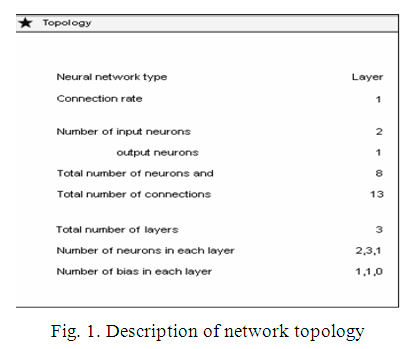
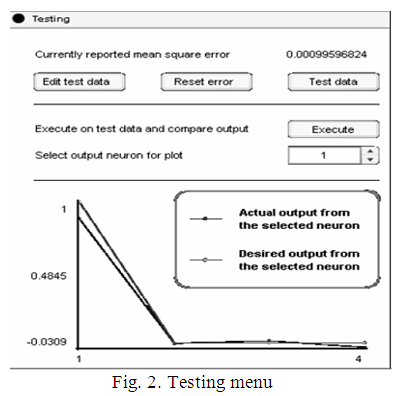
Preparation
of samples (preparatory stage). The
following
samples were
prepared:
training (430
examples), test
(200 examples),
control (25
examples). Since
NN does not accept textual information, samples need to be processed
by marking the text parameters with numerical values. The changes
apply to the first three columns of the sample and the attack tags,
namely: package type (tcp – 1; icmp –
2); type of
service (http
– 1; telnet –
2; ftp_data
– 3; ftp –
4; eco_i
– 5; private –
6; smtp-7;
nhsp-8;
http_443-9);
flag (SF-1;
RSTR-2; RSTO-3;
S0-4; S3-5);
Attack tag
(Back
– 0 0 0 0 1; Buffer_overflow
– 0 0 0 1 0; Quess_pwd
– 0 0 1 0 0; Ipsweep
– 0 1 0 0 0; Neptune
– 1 0 0 0 0). Sampling is given in any
text editor (all values are separated by spaces); file has extension
.train. A fragment of the processed training sample is shown in Fig.
3

Fig.
3. Fragment of
the processed
training sample
Creating
neural
network
in
Fann
Explorer.
Fann Explorer (Fann Artificial Neural
Networks) from Macromedia Inc is a portable environment for the
development, training and testing of neural networks; supports
animation of the training process; implements multilayer artificial
neural networks; has a multi-threaded kernel that provides
computing. The Neural Network was created
with the participation of the student Mamenko
D. V.,
setting of NN
architecture is shown in Fig. 4
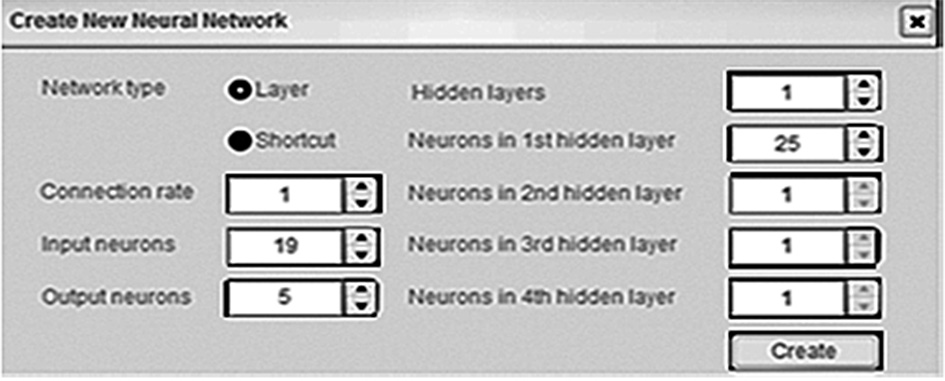
Fig.
4. Setting of NN
architecture
Training
of
neural
network.
The purpose of NN training is to match
such values of its parameters, in which the error of training is
minimal. In the Fann Explorer program, the network training options
are set using the Train tab (Training algorithm).
Incremental
algorithm is a standard reverse error propagation algorithm where
weighting factors are updated after each training period. This means
that weights are updated many times during one training.
Resilent
algorithm is a batch training algorithm that provides good results
for many tasks, the algorithm is adaptive and does not use Training
rate for training.
Quick
algorithm uses the Training rate parameter and gives good results
when solving problems.
Batch
method is a standard reverse propagation algorithm where the weights
are updated after calculating the mean square error for the entire
training sample. Since the average square of the error is calculated
more correctly than in the sequential algorithm, some tasks will
achieve more effective solutions with this algorithm.
Error
Function: Linear is a linear error function that calculates it as
the difference between the actual result given by the neural network
and the expected value that the operator has set; Tangential (Tanh)
is a function of error, which makes a large deviation during
training. The idea of
the
function is that it is better if 10 neurons have an error of 10% at
the output, than one of them will have an error of 100%. This
function is the default error, but it can lead to poor training
outcomes if you set the Training rate too high.
The functions of Hidden layer
activation and Output layer activation are as follows: Symmetric,
Asymmetric-Linear, Sigmoid, Stepwize, Threshold.
The Training menu manages the
training process of NN, sets the adaptation parameters of the NN
link weight factors such as: the number of training periods, the
value of the mean square error, the initial values of the NN link
weight factors using the Initialize button.
Testing
of neural network.
Figure 5 shows a graph of NN testing of
19-1-25-5 configuration after training and testing on the
appropriate samples. The bright line on the graph shows the expected
response, while the darker one is the actual response. The test
error is 0.05868; the lines almost coincide, so NN is well suited to
the task.
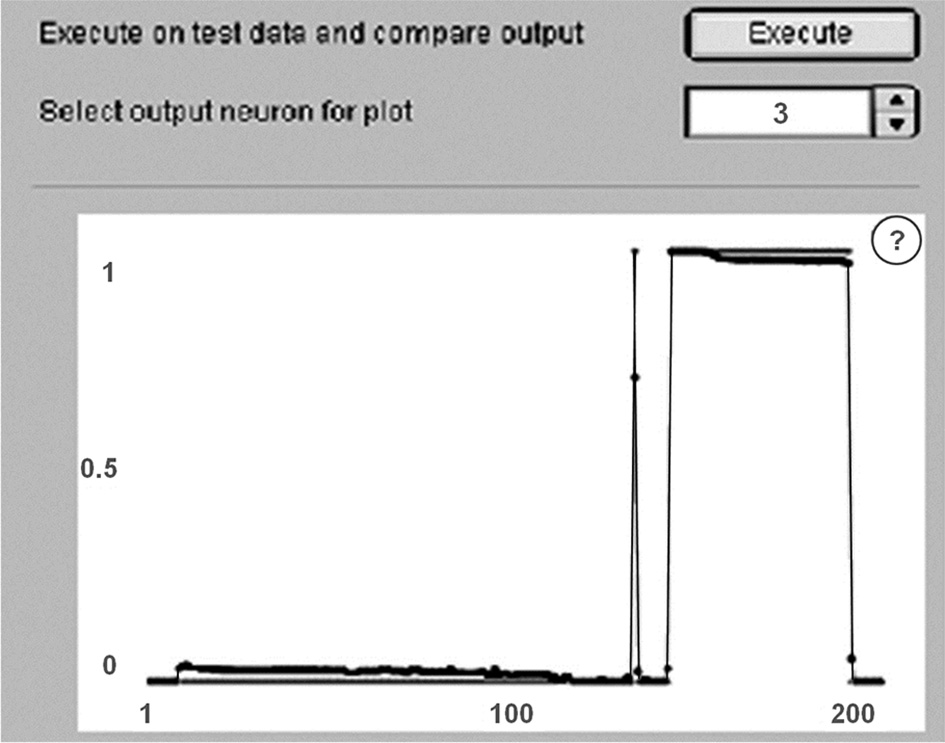
Fig. 5. NN
testing schedule
Analysis
of
the
results.
The NN of 19-1-25-5 configuration was
trained according to the standard algorithm for error propagation
and the training speed of 0.699. Activation function is sigmoid
(symmetric); error function is tangential. NN
passed 6,000
training epochs.
After training (430 examples) and testing
(200 examples), NN determined the error of 0.1066, as shown in Fig.
6
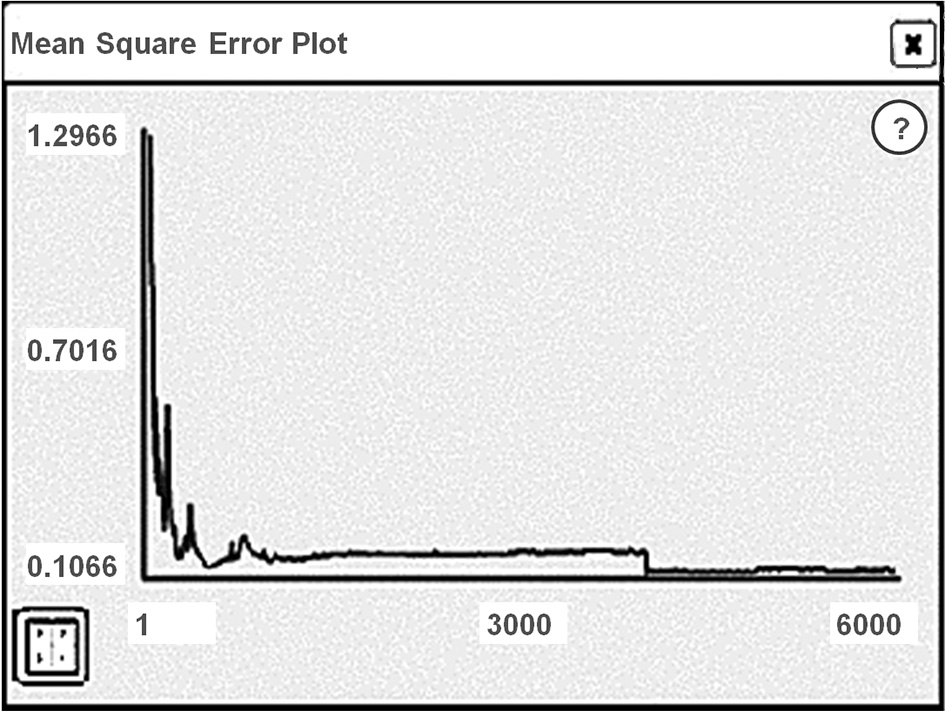
Fig.
6. Error after
NN training
But when
testing on a control sample, which consisted of 25 examples for each
of the five threats, NM determined an error of 0.322. Thus, the NN
copes well with Back, Buffer_overflow and Ipsweep attacks, but it
does not recognize the Quess_password and Neptune attacks. From the
test schedule on the control sample, it can be seen that the first
neuron responsible for detecting the Back attack detected four of
the five threats (the darker line is an expected solution, and the
lighter is the actual one), Fig. 7 (a).
Also, NN recognized all five
threats of Buffer_overflow type, fig. 7 (b). The lines on the chart
are almost the same, but also one of the threats of Back type is
incorrectly assigned by NN to the Buffer_overflow class. The
obtained results of the experimental study are presented in Table 1.
Study of
network training time versus the number of hidden neurons.
The study was carried out on NN with
different number of neurons in a hidden layer: from 10 to 55.
Experiments were carried out on the following models: Model No. 1
(Initialize Resilent Sigmoid Stepwise Algorithm), Model No. 2
(Randomize Batch Sigmoid Symmetric Algorithm). The results of
studies are presented in Table 2.
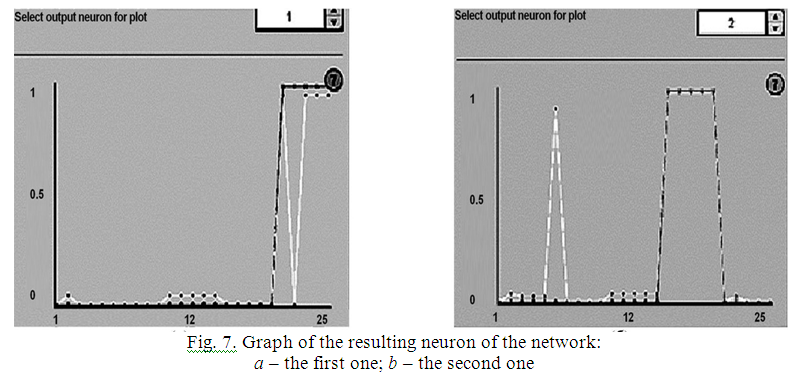
Table
1
Results
of NN
operation on
a control
sample
|
Attack
|
Number
of attacks
|
Number of detected attacks
|
Number
of recognition errors
|
|
Back
|
5
|
4
|
1
|
|
Buffer_overflow
|
5
|
5
|
1
|
|
Quess_password
|
5
|
2
|
5
|
|
Ipsweep
|
5
|
4
|
1
|
Table
2
Dependence
of NN
training time
on the
number of
hidden neurons
|
Number
of neurons in the hidden layer
|
Model
No. 1
|
Model
No. 2
|
|
|
Error
|
Number
of training epochs
|
Error
|
Number
of training epochs
|
|
10
|
0.1982
|
20 039
|
0.1996
|
6 387
|
|
15
|
0.1994
|
253
|
0.2021
|
2 000
|
|
25
|
0.197
|
214
|
0.1993
|
33
|
|
35
|
0.196
|
170
|
0.1977
|
22
|
|
45
|
0.1964
|
116
|
0.1960
|
18
|
|
55
|
0.199
|
249
|
0.193
|
35
|
When
increasing the number of neurons in the hidden layer, the NN is
trained faster, but in some cases, when the optimal amount starts to
exceed (> 45), the training rate falls. In addition, model No. 2
is trained much faster than model No. 1. The constructed graphs of
dependence of the number of epochs on the number of neurons in the
hidden layer under different training algorithms are presented in
Fig. 8.

Fig. 8.
Dependence of the number of epochs on the number of hidden neurons
Study of
training time versus the number of hidden layers.
The study was carried out on NN with a different number of hidden
layers: from 1 to 4; 15 formal neurons in each. Experiments were
carried out on the following models: Model No. 3 (Incremental
Training rate 0.4), Model No. 4 (Resilient Training rate 0.8). The
initialization algorithm was Randomize, activation function –
sigmoid (symmetric). The results of experimental studies are listed
in Table. 3.
Table
3
Dependence
of NN
training time
on the
number of
hidden layers
|
Number
of hidden layer
|
Model
No. 3
|
Model
No. 4
|
|
|
Error
|
Number
of training epochs
|
Error
|
Number
of training epochs
|
|
1
|
0.1495
|
93 775
|
0.1694
|
164
|
|
2
|
0.1994
|
551
|
0.01394
|
178
|
|
3
|
0.1279
|
484
|
0.1413
|
224
|
|
4
|
0.1435
|
2272
|
0.1478
|
547
|
The graphs of the dependence of
the number of training epochs on the number of hidden layers based
on different training algorithms are plotted and shown in Fig. 9.
From
the figure
it can
be seen
that when
increasing the
number of
hidden layers
(> 3) in NN,
training
accelerates only
to a
certain point,
until the
layers become
too many,
then the
network begins
to slow
down. In
addition, the model No. 4 is trained almost twice as fast as the
model No. 3, but has a bigger error, which results from an increased
training rate.
Originality
and practical value
The
originality lies
in the
fact that
there are
found
dependencies of
the training
time (number
of epochs)
of the
multilayer
neural network
on the
number of
hidden layers
and hidden
neurons
according to
different
training
algorithms. The
practical value is that the network traffic parameters, using the
19-1-25-5 configuration neural network, will allow in real-time to
detect the threats of Back, Buffer_overflow, Quess_password,
Ipsweep, Neptune on the computer network and carry out appropriate
control.
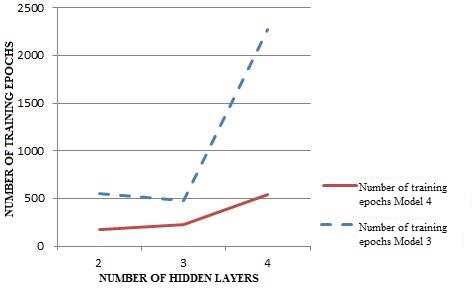
Fig.
9. Dependence of the number of training
epochs
on the number of hidden layers
Conclusions
At the preparatory stage,
based on the data of the KDDCUP-99 database, the following samples
were generated: training (430 examples), test (200 examples),
control (25 examples).
To determine the attacks
(Back, Buffer_overflow, Quess_password, Ipsweep, Neptune) in the
computer network, the Fann Explorer program created NN of 19-1-25-5
configuration, with 19 network traffic parameters inputted;
training, testing (error 0.1) and evaluation of the received
results (error 0.3) on the corresponding samples were conducted. In
particular, the first neuron responsible for recognizing the Back
attack detected four of the five threats.
Experimental studies of the
dependence of the training time (number of epochs) on the number of
hidden neurons (from 10 to 55) on NN were conducted: Model No. 1
(Resilient algorithm), Model No. 2 (Batch algorithm); the Batch
algorithm NM is trained three times faster than the NN based on the
Resilient algorithm. The experimental studies of the dependence of
the training time on the number of hidden layers (from 1 to 4) on
the NN were conducted: Model No. 3 (Incremental algorithm), Model
No. 4 (Resilient algorithm); the Resilient algorithm NM is trained
almost twice as fast as NN by the Incremental algorithm.
LIST OF REFERENCE LINKS
Гришин,
А. В. Нейросетевые технологии в задачах
обнаружения компьютерных атак / А. В.
Гришин // Информационные технологии и
вычислительные системы. – 2011. – № 1. –
С. 53–64.
Жульков,
Е. В. Построение модульных нейронных
сетей для обнаружения классов сетевых
атак [Electronic
resource]
: автореф. дис. …
канд. техн. наук : 05.13.19 / Жульков Евгений
Владимирович ;
Санкт-Петербург.
гос. политехн. ун-т. – Санкт-Петербург,
2007. – 15 с. – Available
at:
http://elib.spbstu.ru/dl/1501.pdf/view. – Title
from the
screen. –
Accessed :
15.02.2018.
Корпань,
Я. В. Комплекс методів та
засобів захисту інформації в комп’ютерних
системах / Я. В. Корпань // Мир науки и
инноваций. – 2015. – Т. 3.
– С. 31–35.
Марченко,
А. К. Обнаружение атак в системах
нейросетевыми средствами / А. А. Марченко,
С. В. Матвиенко, Ф. Г. Нестерук // Науч.-техн.
вестн. информационных технологий,
механики и оптики.
– 2007.
– № 39. –
С. 83–93.
Пахомова,
В. М. Можливості модернізації комп’ютерної
мережі інформаційно-телекомунікаційної
системи Придніпровської
залізниці / В. М. Пахомова // Інформ.-керуючі
системи на залізн. трансп. – 2015. – №
5. – С. 32–38.
Пилюгина,
К. Н. Применение нейронных сетей с целью
обнаружения вторжений [Electronic
resource] / К.
Н. Пилюгина // Современные научные
исследования и инновации. – 2016. – №
2. – Available
at: http://web.snauka.ru/issues/2016/02/63248.
/
– Title from
the screen.
– Accessed :
19.02.2018.
Писаренко,
И. Нейросетевые технологии в безопасности
[Electronic
resource] / И.
Писаренко // Information Security.
– 2009.
– № 4. –
Available at:
http://www.itsec.ru/articles2/Oborandteh/neyrosetevye-tehnologii-v-biznese.
– Title from
the screen.
– Accessed :
19.02.2018.
Постарнак,
Д. В. Критический анализ моделей
нейронных сетей / Д. В. Постарнак //
Вестн. Тюмен. гос. ун-та.
Физико-математ. науки. Информатика.
– 2012. – № 4. – С. 162–167.
Amini,
M. Effective Intrusion Detection with a Neural Network Ensemble
using Fuzzy Clustering and Stacking Combination Method / M. Amini,
J. Rezaeenour, E. Hadavandi // Journal of Computing and Security. –
2015. –
Vol. 1. –
Iss. 4. –
P. 293–305.
Amini,
M. A Neural Network Ensemble Classifier for Effective Intrusion
Detection using Fuzzy Clustering and Radial Basis Function Networks
/ M. Amini, J. Rezaeenour, E. Hadavandi // Intern. Journal
on Artificial Intelligence Tools.
–
2016. –
Vol. 25. –
Iss. 02. –
P. 1550033. doi:
10.1142/s0218213015500335.
A
Survey of Artificial Immune System Based Intrusion Detection / Hua
Yang, Tao Li, Xinlei Hu, Feng Wang, Yang Zou //
The
Scientific World Journal. –
2014. – Vol.
2014. –
P. 1–11. doi: 10.1155/2014/156790.
Branitskiy,
A. Network attack detection based on combination of neural, immune
and neuro-fuzzy classifiers / A. Branitskiy, I. Kotenko // 2015
IEEE 18th Intern. Conf. on Computational
Science and Engineering : Conf. Paper
(21–23 Oct. 2015). –
Porto, Portugal, 2015. –
P. 152–159. doi:
10.1109/cse.2015.26.
Cannady,
J. Artificial Neural Networks for Misuse
Detection / J. Cannady // Proc.
of the 21st
National Information Systems Security Conference (October
5–8,
1998). –
Arlington, Virginia,
1998. – P.
443–456.
KDDCup1999Data
[Electronic
resource]. –
Available at:
http://kdd.ics.uci.edu/databases/kddcup99/kddcup99.html. –
Title from
the screen.
– Accessed :
19.02.2018.
Moradi,
M. System for intrusion Detection and Classification of Attacks
[Electronic
resource] //
Інформаційний портал університету
Квінс. – 2013. – Available
at:
http://research.cs.queensu.ca/moradi/148-04-mm-mz.pdf.
– Title from
the screen.
– Accessed :
19.02.2018.
Pakhomova,
V. M. Network Traffic Forcasting in information-telecommunication
System of Prydniprovsk Railways Based on Neuro-fuzzy Network / V.
M. Pakhomova //
Наука та
прогрес транспорту.
– 2016. – № 6 (66). – C.
105–114. doi: 10.15802/stp2016/90485.
І. В. Жуковицький1*,
В. М. ПАХОМОВА2*
1*Каф.
«Електронні обчислювальні машини»,
Дніпропетровський національний
університет залізничного транспорту
імені академіка В. Лазаряна, вул.
Лазаряна, 2,
Дніпро, Україна, 49010, тел.
+38 (056) 373 15 89,
ел. пошта ivzhuk@ua.fm, ORCID
0000-0002-3491-5976
2*Каф.
«Електронні обчислювальні машини»,
Дніпропетровський національний
університет залізничного транспорту
імені академіка В. Лазаряна, вул.
Лазаряна, 2,
Дніпро, Україна, 49010, тел.
+38 (056) 373 15 89,
ел. пошта viknikpakh@gmail.com,
ORCID 0000-0002-0022-099X
ВИЯВЛЕННЯ ЗАГРОЗ У
КОМП’ЮТЕРНІЙ МЕРЕЖІ
НА
ОСНОВІ БАГАТОШАРОВОЇ
НЕЙРОННОЇ МЕРЕЖІ
Мета.
Останнім часом все частіше
з’являються повідомлення про проникнення
в комп’ютерні мережі та атаки на
Web-cервери. Атаки поділяють на наступні
категорії: DoS, U2R, R2L, Probe. Метою статті є
виявлення загроз у
комп’ютерній мережі на основі параметрів
мережного трафіка з
використанням нейромережної технології,
що дозволить захистити сервер. Методика.
Виявлення в комп’ютерній мережі таких
загроз, як Back, Buffer_overflow,
Quess_password, Ipsweep, Neptune здійснено
на основі аналізу та
обробки даних про параметри мережних
з’єднань, що використовують стек
протоколів TCP/IP, із застосуванням
нейронної мережі
конфігурації 19-1-25-5 у
програмі Fann Explorer.
Під час моделювання роботи нейронної
мережі використані навчальна (430
прикладів), тестова (200 прикладів) та
контрольна (25 прикладів) вибірки, що
складені на основі відкритої бази даних
KDDCUP-99 із 5 000 000 записів про з’єднання.
Результати.
Створена нейронна мережа на контрольній
вибірці визначила похибку в 0,322.
Визначено, що мережа
конфігурації 19-1-25-5 добре
справляється з такими атаками, як Back,
Buffer_overflow та Ipsweep. Для розпізнання атак
Quess_password і Neptune недостатньо
завдання 19 параметрів мережного трафіку.
Наукова новизна.
Отримані
залежності часу навчання (кількості
епох) нейронної мережі від кількості
нейронів у прихованому шарі (від 10 до
55) та кількості прихованих шарів (від
1 до 4). За умови збільшення
кількості нейронів у
прихованому шарі нейронна мережа за
алгоритмом Batch навчається швидше майже
в три рази, ніж нейронна мережа за
алгоритмом Resilient. Якщо збільшити
кількість прихованих
шарів, нейронна мережа за алгоритмом
Resilient навчається майже в два рази швидше,
ніж за алгоритмом Incremental. Практична
значимість. На
основі параметрів
мережного трафіка використання нейронної
мережі конфігурації 19-1-25-5
дозволить у реальному часі виявити
загрози Back, Buffer_overflow, Quess_password, Ipsweep,
Neptune на комп’ютерну мережу та здійснити
відповідний контроль.
Ключові слова: мережний трафік;
загроза; нейронна мережа; вибірка;
прихований шар; приховані нейрони;
алгоритм навчання; кількість епох;
похибка
И. В. ЖУКОВИЦКИЙ1*,
В. Н. ПАХОМОВА2*
1*Каф.
«Электронные вычислительные
машины», Днепропетровский
национальный
университет
железнодорожного транспорта имени
академика В. Лазаряна, ул. Лазаряна, 2,
Днипро, Украина, 49010,
тел. +38 (056) 373 15 89,
эл. почта ivzhuk@ua.fm
,
ORCID 0000-0002-3491-5976
2*Каф.
«Электронные вычислительные машины»,
Днепропетровский национальный
университет железнодорожного транспорта
имени академика В. Лазаряна, ул. Лазаряна,
2,
Днипро,
Украина, 49010, тел. +38 (056)
373 15 89,
эл. почта viknikpakh@gmail.com,
ORCID 0000-0002-0022-099X
ВЫЯВЛЕНИЕ УГРОЗ В КОМПЬЮТЕРНОЙ
СЕТИ
НА ОСНОВЕ МНОГОСЛОЙНОЙ НЕЙРОННОЙ
СЕТИ
Цель. В
последнее время все чаще появляются
сообщения о проникновении в компьютерные
сети и атаки на Web-cерверы. Атаки
подразделяют на следующие категории:
DoS, U2R, R2L, Probe. Целью статьи является
выявление угроз в компьютерной сети
на основе параметров сетевого трафика
с использованием нейросетевой технологии,
что позволит защитить сервер. Методика.
Обнаружение в компьютерной сети таких
угроз как Back, Buffer_overflow, Quess_password, Ipsweep,
Neptune осуществлено на основе анализа и
обработки данных о параметрах сетевых
соединений, что используют стек
протоколов TCP/IP, с
применением нейронной сети конфигурации
19-1-25-5 в программе Fann Explorer. При моделировании
работы нейронной сети использованы
учебная (430 примеров), тестовая (200
примеров) и контрольная (25 примеров)
выборки, составленные на основе открытой
базы данных KDDCUP-99 с 5 000 000 записей
о соединении. Результаты.
Созданная нейронная
сеть на контрольной выборке определила
погрешность в 0,322. Определено, что сеть
конфигурации 19-1-25-5 хорошо справляется
с такими атаками как Back, Buffer_overflow и
Ipsweep. Для распознавания атак Quess_password и
Neptune недостаточно задания 19 параметров
сетевого трафика. Научная
новизна. Получены
зависимости времени обучения (количества
эпох) нейронной сети от количества
нейронов в скрытом слое (от 10 до 55) и
количества скрытых слоев (от 1 до 4). При
условии увеличения количества нейронов
в скрытом слое нейронная сеть по
алгоритму Batch учится быстрее почти в
три раза, чем нейронная сеть по алгоритму
Resilient. Если увеличить количество скрытых
слоев, нейронная сеть по алгоритму
Resilient учится почти в два раза быстрее,
чем по алгоритму Incremental. Практическая
значимость. На основе
параметров сетевого трафика использование
нейронной сети конфигурации 19-1-25-5
позволит в реальном времени обнаружить
угрозы Back, Buffer_overflow, Quess_password, Ipsweep, Neptune
на компьютерную сеть и осуществить
соответствующий контроль.
Ключевые слова: сетевой трафик;
угроза; нейронная сеть; выборка; скрытый
слой; скрытые нейроны; алгоритм обучения;
количество эпох; погрешность
REFERENCES
Grishin, A. V. (2011). Neyrosetevye tekhnologii
v zadachakh obnaruzheniya kompyuternykh atak. Informa-tsionnye
tekhnologii i vychislitelnye sistemy,
1, 53-64. (in Ukranian).
Zhulkov,
Y. V. (2007). Postroenie
modulnykh neyronnykh
setey dlya
obnaruzheniya klassov
setevykh atak
(Dysertatsiia
kandydata tekhnichnykh
nauk). Peter
the Great St. Petersburg Polytechnic University, Saint Petersburg.
(in Russian)
Korpan,
Y. V. (2015). Kompleks metodiv ta zasobiv
zakhystu informatsii v kompiuternykh systemakh. Mir
nauki i innovatsiy, 3, 31-35. (in
Ukrainian)
Marchenko,
A. A.,
Matvienko, S.
V., &
Nesteruk, F.
G. (2007).
Obnaruzhenie atak v sistemakh neyrosetevymi sredstvami. Scientific
and
Technical
Journal
of
Information
Technologies,
Mechanics
and
Optics,
7(5), 83-93. (in English)
Pakhomоva,
V. N. (2015). The possibilities of
upgrading the computer network of information-telecommunication
system of Dnieper railway. Informatsiino-keruiuchi
systemy na zaliznychnomu transporti, 5, 32-38.
(in Ukranian)
Piliugina,
K. N.
(2016). Artificial
neural network
approaches to
intrusion
detection.
Modern Scientific Researches and
Innovations, 2. Retrived
from
http://web.snauka.ru/issues/2016/02/63248.
(in Russian)
Pisarenko,
I. (2009). Neyrosetevye tekhnologii v
bezopasnosti . Information
Security, 4.
Retrived from
http://www.itsec.ru/articles2/Oborandteh/neyrosetevye-tehnologii-v-biznese.
(in Russian)
Postarnak,
D. V. (2012). Kriticheskiy analiz modeley neyronnykh setey. Vestnik
Tyumenskogo gosudarstvennogo universiteta. Fiziko-matematicheskie
nauki. Informatika, 4, 162-167. (in
Russian)
Amini,
M.,
Rezaeenour, J., & Hadavandi, E. (2015).
Effective
Intrusion
Detection with
a Neural
Network
Ensemble using
Fuzzy
Clustering and
Stacking
Combination
Method. Journal
of Computing and Security, 1(4),
293-305. (in English)
Amini,
M. A., Rezaeenour, J., & Hadavandi, E. (2016). Neural Network
Ensemble Classifier for Effective Intrusion Detection using Fuzzy
Clustering and Radial Basis Function Networks. International
Journal
on Artificial Intelligence
Tools, 25 (02), 1550033. doi:
10.1142/s0218213015500335.
(in English)
Hua
Yang, Tao Li, Xinlei Hu, Feng Wang, & Yang Zou. (2014). A
Survey of Artificial Immune System Based Intrusion Detection. The
Scientific World Journal, 2014,
1-11.
doi: 10.1155/2014/156790.
(in English)
Branitskiy,
A., & Kotenko, I. (2015). Network attack detection based on
combination of neural, immune and neuro-fuzzy classifiers. The
18th IEEE Intern. Conf. on Computational Science and Engineering
(IEEE CSE2015), 152-159. doi:
10.1109/cse.2015.26.
(in English)
Cannady,
J. (1998). Artificial Neural Networks for
Misuse Detection. Proceedings
of the 21st
National Information Systems Security Conference (NISSC)
(October
5–8,
1998), 443-456.
(in English)
KDDCup1999Data
(1999). Retrived
from
http://kdd.ics.uci.edu/databases/kddcup99/kddcup99.html. (in
English)
Moradi,
M. (2013). System for intrusion Detection and Classification of
Attacks.
Інформаційний портал
університету Квінс.
Retrived from
http://research.cs.queensu.ca/moradi/148-04-mm-mz.pdf.
(in English)
Pakhomova,
V. M. (2016). Network Traffic Forcasting in
information-telecommunication System of Prydniprovsk Railways Based
on Neuro-fuzzy Network. Science and
Transport Progress, 6(66),
105-114.
doi:
10.15802/stp2016/90485. (in English)
Prof.
A. A. Kosolapov,
Dr. Sc. (Tech.) (Ukraine)
recommended this
article to be
published
Received:
Jan. 09,
2018
Accessed:
April 11,
2018
d oi
10.15802/stp2018/130797 ©
I.
V.
Zhukovyts’kyy,
V.
N.
Pakhomovа,
2018
oi
10.15802/stp2018/130797 ©
I.
V.
Zhukovyts’kyy,
V.
N.
Pakhomovа,
2018
)
[14]: package
type (TCP,
UDP, ICMP
and others);
service type
(http, telnet,
ftp_data,
eco_i,
private); flag;
number of
bytes from
source to
recipient;
number of
bytes from
recipient to
source; number
of hot
indicators;
successful
entrance; number
of compromised
conditions;
number of
connections to
the host
for 2 s;
number of
connections to
one service
for 2 s;
percentage of
connections to
the service
for 2 s;
percentage of
connection to
different hosts;
number of
connections to
the local
host installed
by the
remote side
for 2 s;
number of
connections to
the local
host installed
by the
remote side,
uses 1 service;
percentage of
connections to
this service;
percentage of
connections to
other services;
percentage of
connections to
the host
with the
port number
of the
source;
percentage of
connections with
a rej-type
error for
the recipient
host; percentage
of connections
with a
rej-type error
for the
service. On
the basis of
the values of
the set of
the attack
features, it is
necessary to
carry out the
classification conclusion
(
,
,
,
,
)
of the following threats: Back, Buffer_overflow, Quess_password,
Ipsweep, Neptune. Detection of threats in a computer network is
based on the analysis and processing of data on the parameters of
network connections using the TCP/IP protocol stack. As initial data
we used KDDCUP-99 database of 5,000,000 connection records (the
sequence of TCP packets for the final period, the start and end
points of which are clearly defined, during which the data is
transmitted from the sender's IP address to the recipient’s IP
address using the defined protocol). As a mathematical tool of
problem solution we took the neural network (NN) of the
configuration 19-1-25-5, where 19 is the number of neurons in the
input layer, 1 is the number of hidden layers, 25 is the number of
neurons in the hidden layer, and 5 is the number of neurons in the
resulting layer.